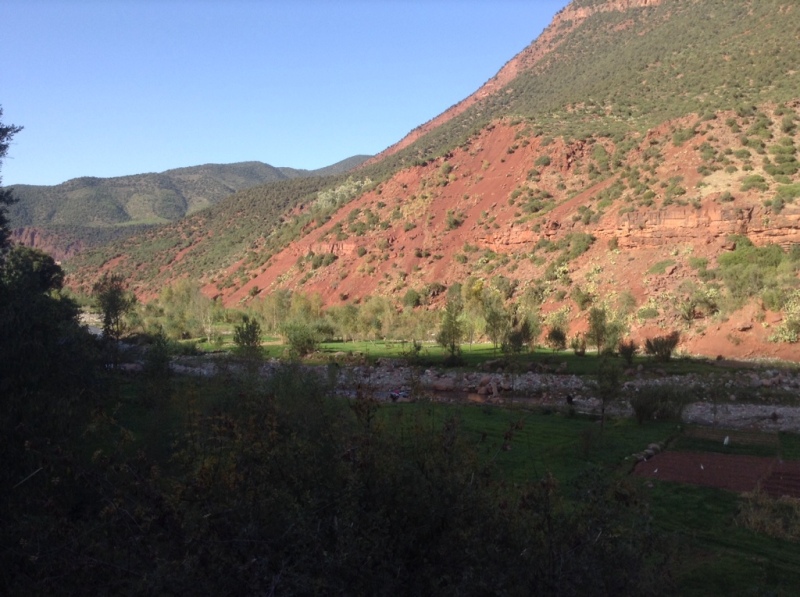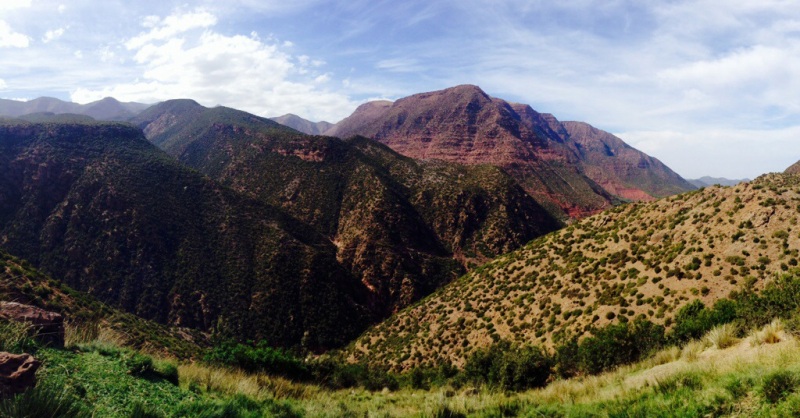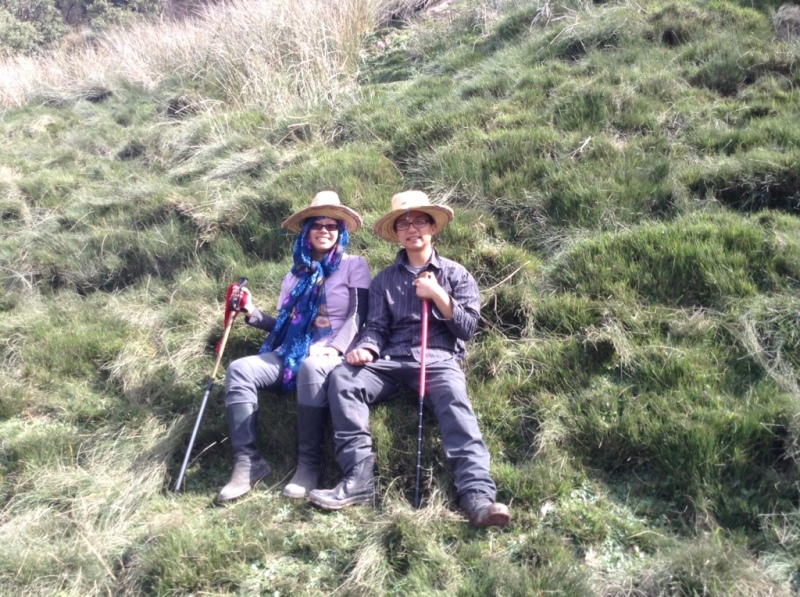Our first official tour of Iceland, and first day out of the city! The Golden Circle is probably the most famous touristy thing to do in Reykjavik, which is a day tour outside of the city where you get to look at geysers, waterfalls, geothermic hot spots, and nature. There’s probably at least a dozen bus companies in the city that run this tour daily, and they have different variations of the tour as well, like an afternoon-only or evening-only tour (cheaper, but subsequently less to see).

Our happy little bus!
We decided to go with small group tours, since we previously experienced being herded around like cattle in 50-person buses in Washington & Hawaii. We chose a company called Sterna Travel because they had small groups and good reviews on Trip Advisor. Honestly, we wanted to book with IC Highland since they had the cheapest prices around (kr7900 per person) and they were a small company. However, they were fully booked through Monday.
Sterna Travel was actually a pretty good tour group, it was kr9800 per person, not including lunch or tip. The tour we chose was Golden Circle & Green Energy. The group ended up being 4 people, and we shared the bus with a cute elderly couple from Alaska. Our driver, Beggi (pronounced “Becky”) was quite personable and took us to pretty much the 3 main attractions:
– Gulfoss waterfall
– Geysir (dormant) & Strokkur (active) geysers
– Thingveller National Park (tectonic plates, forests, rocks, old Parliament)
Those are pretty much the basics for any Golden Circle tour. Depending on your company, you might see other stuff too. We also got to check out:
– Hellisheioi Power Plant (admission included)
– Kerio crater (the sneaky ghetto & free entrance that smaller buses can go through)
– feeding horses! (the driver knew some of the farmers and they let us pull over and feed horses)
– Faxi waterfall (smaller than Gulfoss but still pretty)
We learned that Beggi was from Akureyri, a town in northern Iceland, worked 2 jobs, and that he has a summer house on the Golden Circle.
The Hellisheioi geothermal power plant was pretty cool, we were given a short guided tour by a hip-looking fellow, and watched a few videos (reminiscent of a scene from Jurassic Park) about how they converted geothermal energy into heating for homes & other uses. One really cool fact we found out was that all the hot water (the smelly sulfur water) that gets used in people’s homes gets flushed down pipes that run throughout the streets of Reykjavik. This heated water then warms the sidewalks, meaning that people never have to shovel snow, because it all melts from the heat.

Nefarious smoke in the distance…

Nice building
We also found out that the plant is insanely efficient and generates so much cheap energy, Icelanders can’t even use it all. For example, even when being wasteful (which the guide admitted himself), like leaving lights on, or leaving heaters on, Icelanders only use 10% of all energy generated. So where does 90% of all energy go? It’s sold to foreign corporations. One of the major foreign companies established in Iceland is an American aluminum-production factory, and they use 90% of all Icelandic geothermal energy. Somehow this all sounds like the beginnings of a plot device for a James Bond movie. Our driver said he pays about $500/year for his entire heating bill.

Totally right out of Jurassic Park

Tour guide explaining how Reykjavik consumes energy

Only 18 people work in this gigantic plant.
After that we went to a rest stop. It’d be your typical rest stop if it weren’t for the giant gaping trench running through the center of the building from a recent earthquake. There was an art exhibit on furniture destroyed by earthquakes, but it wasn’t very impressive.

Giant crack in the earth! (Lights are fake)
The next place we went to was a red crater. I’m not sure how it was a crater (looked like a giant construction pit to me), but the dirt was bright red. It looked cool though, it’s what I’d imagine a Martian landscape to look like.

Mars!
Faxi Waterfall was our next stop. “Faxi” means “mane” in Icelandic apparently, so the waterfall looks like a horse’s mane. It was a pretty small (or distant?) waterfall, but it was empty except for our group, so it was nice to have a look. I should probably note that it was raining and cold for a majority of our day, and it didn’t really hit me that it was going to be so cold until we got to Faxi.

Faxi Waterfall (note the salmon stream on the far left)

Faxi Waterfall
After that, we drove a bit along the countryside, with Beggi telling us about life in his summer home (which he actually visits every weekend when he can), and telling us stories about the people that lived in the houses we drove past.
Eventually we arrived at Gullfoss Waterfall, which is two waterfalls in one (combined height of approx 100ft). It definitely reminded me of Niagara Falls, but it supposedly generates more force altogether. It did look pretty majestic. It was formed by a bunch of flash floods ages ago, and there’s a pretty deep and long canyon at the base of the falls.
There was a pathway where you could walk all the way to the top of the falls, and it was freezing. I remembered that parts of Prometheus were shot in Iceland, and wondered how the actors were able to stand in such cold weather on the waterfall (check the deleted scenes).

Gullfoss

Gullfoss & gorge

Top of Gulfoss
Aside from the waterfall itself, there was a cafeteria at the top of the gorge where we had our first bowl of lamb soup. It consisted of vegetables and chunks of lamb in a salted, savory broth. Unfortunately, we were both so hungry we forgot to take pictures. Fortunately, we had free refills! The soup was about 1490 isk, which is pretty pricey, but it was a really big bowl.
Next stop was the Geysir geothermal area. The whole area is a giant hot pocket of geothermal activity, and made up of little hot springs, pools, and two geysers. Geysir is the grandfather of the bunch, and the 2nd largest geyser in the world, back when it was spouting (up to 263ft). Eventually the government (or some agency) decided to keep it under control and poured a ton of soap into its chute, so it now longer spouts (but it still boils and bubbles). Poor fella. At least that’s what I think the tour guide said (I should really cross-check this on Wikipedia, but not right now).

Sad, inactive Geysir

Deadly hot tub

Steamy!
The only actively spouting geyser in the area is Strokkur, and it spouts every 6-8 minutes, which is pretty often. You’ll see a bunch of tourists in the area holding their cameras up, waiting to take that perfect shot (I’m guilty of it too), but it definitely is a sight to behold. The way it tries to break the surface and bubbles and shoots up is a pretty neat-looking process.

Strokkur

Geyser eruption

Hot bed of activity

Dramatic steam photo
On our way to Thingvellir National Park, our guide pulls over next to a horse farm. He was friends with the owner of the farm, and wanted to make a pit stop to feed her horses (apparently this is something he does often when he does this tour). We fed horses! Icelandic horses are pretty stout-looking, their legs are a bit shorter than horses I’ve seen, but their coats are thick (and bellies are chunky). Horses were brought over from Norway by the first settlers, and they’ve been bred ever since. Icelandic horses nowadays are used for sport and export, rather than farming. Germany actually imports a good number of Icelandic horses. The driver mentioned that the horses were once shipped to the continent for a game ceremony (Olympics maybe?), but once the ceremony was over, Iceland refused to take them back (in case of parasites).

Feeding horses

Photobomb!

Stout horses
Once we reached Thingvellir, a miracle happened: the sun came out! We could finally see the blue sky! And it was perfect timing, because Thingvellir is quite breathtaking. The leaves are changing color, the rivers and lakes are pristine, everything is picturesque.

Looking at the countryside

Pristine lake
At one point, our driver pulled over again (he has a habit of doing this, but it’s for our benefit), and led us down a path towards a lake. He started taking plastic cups and scooping up water from the lake for us to drink. Mark was a bit hesitant because there was a duck swimming nearby, but the water was gorgeous and you could see the bottom, so I took a swig. We drank real water! From a lake! And we didn’t die or grow diseases! It was pure water, and it felt so weird to drink straight from a source. Quite refreshing! The driver also picked blueberries from a bush and handed them out. Real Icelandic blueberries!

Hiking down to the lake

Lakeside

Drink up!
Thingvellir sits on top of two tectonic plates, the American and Eurasian. The plates created so many deep trenches, that this park is considered a great place for scuba diving. The water is crystal clear!

Gorge created by tectonic shifts

So clear!
It also happens to house the old Parliament, Althingi. Back in the day, chieftains and settlers would convene in this location and talk about laws. It used to also house fairs and booths, but I think those stopped after the 1800s.




The tour was great, I’d highly recommend going with Sterna, or any small group tour. I think that definitely made a huge difference in our experience. Our guide genuinely seemed to enjoy showing us around (especially with the unplanned pit stops), like he was giving us a tour of his backyard. In hindsight, he literally was, since his summer house was on the tour route.
—–
As for our Northern Lights tour, unfortunately not much can really be said for it except:
– We went with Reykjavik Excursions (50-person bus)
– It was raining & cloudy at night
– We could barely see anything! We saw some faint glows, but they were covered by clouds
– You could only see the lights clearly through a camera lens, and since our iPods/iPhones don’t have high ISO, we couldn’t take pics
– We wanted to reschedule for tonight (since we get another trip for free if the first one fails), but they canceled the tour due to weather. It was clear and not raining tonight! -_-
Ah well, this further fuels our desire to visit Alaska.
As always, the rest of our photos are up (or will be) on Flickr. There were just too many great ones from today!
64.136869
-21.921866











































































You must be logged in to post a comment.